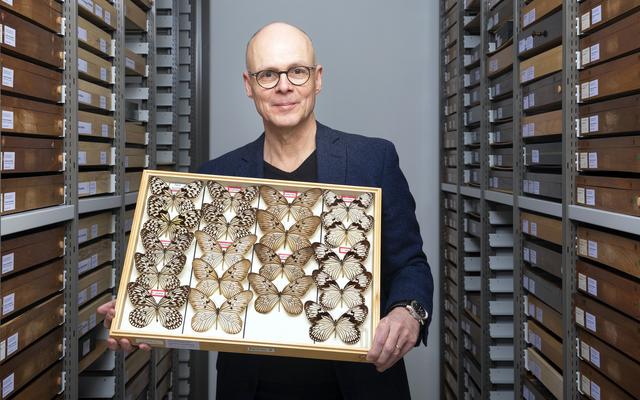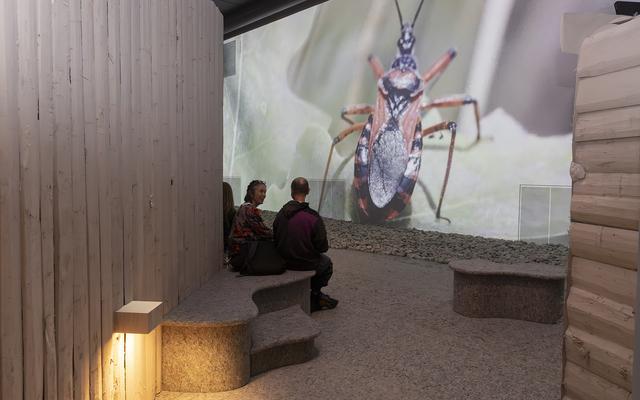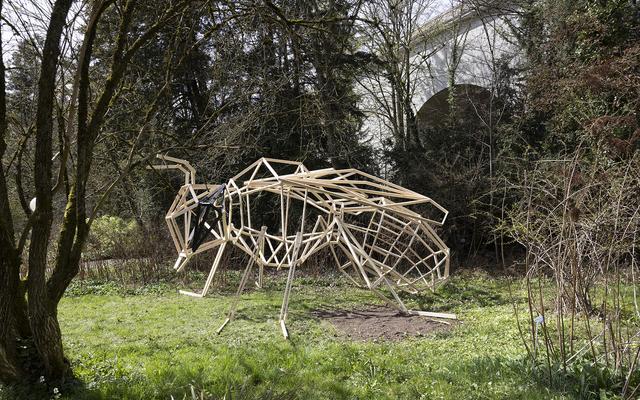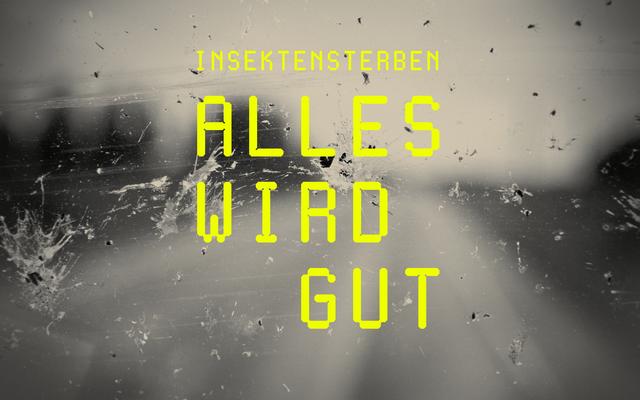‘I can certainly do without mosquitoes’ – this is a common sentiment. Yet we humans are dependent on every insect, including mosquitoes. Even if an insect doesn’t play an important role in pollination and therefore in our food supply, it’s still an important source of food for other animals, such as birds and amphibians. Insects also ensure that dead plants and carrion are decomposed, thus maintaining the balance in nature. In short, without insects, there would be no life on earth. Nevertheless, three-quarters of the biomass of flying insects has disappeared in just 30 years. Researchers found the greatest decline in areas with intensive agricultural operations. But insects are dying out in forests, too. Insect biomass in forests decreased by 41 per cent between 2008 and 2017. In meadows, the decline was even greater – 67 per cent. We are in the midst of a global extinction on a scale similar to the last mass extinction sixty million years ago, when the dinosaurs disappeared from the face of the earth.
There is still cause for hope!
Following the success of Queer – Diversity is in our Nature, the Natural History Museum of Bern is once again tackling a highly topical, socio-politically relevant subject with its new special exhibition Insect Decline – It’s Going to be All Right. The exhibition takes a surprising and provocatively optimistic approach by ushering visitors into the future, more precisely into the year 2053. From there, they look back at our present, and the numerous effective approaches and initiatives that have managed to avert the great insect extinction.
Ausstellungsführungen
- Reguläre Ausstellungsführung
-
Lassen Sie sich von unseren Guides durch die Ausstellung führen. Die Daten und Anmeldemöglichkeiten finden Sie hier.
Vermittlungsangebot
- Individueller Klassenbesuch
-
Sie wollen mit Ihrer Schulklasse die Ausstellung besuchen? Sämtliche Informationen, Termine und das Anmeldeformular finden Sie hier.
- Teilnahme Schulworkshop
-
Sie interessieren sich für einen angeleiteten Workshop mit Ihrer Klasse? Sämtliche Informationen, Termine und das Anmeldeformular finden Sie hier.
- Kontakt
-
Wenden Sie sich an unser Team Bildung und Vermittlung für weitere Informationen.
To book private guided tours, workshops (for groups, companies etc.) and events in the exhibition, please contact the Head of Catering and Events or book the event directly on our website.
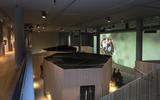
In each of the five individually designed rooms which focus on the topics of Agriculture, Pesticides, Climate Change, The Fascination of Insects, and Habitats, a person involved in saving insects in 2023 addresses visitors. Using headphones as well as information in the exhibition space, visitors can learn about what each of the speakers has initiated. They include an insect specialist, a forester, a pesticide researcher, a farmer and a group of activists.
From his kitchen, former scientific illustrator and Natural History Museum of Bern entomologist Hans-Peter Wymann talks about his fascination with butterflies and insects, which began in childhood. Take a seat and make yourself at home. And don’t forget to take a look in the kitchen cupboards to find out more about the importance of insects!
A form of agriculture that not only feeds people but also benefits insects and biodiversity – this is possible, as Tina Siegenthaler and her Fondlihof farm demonstrate. This room presents a number of other farms that are already practising the agriculture of the future. They prove that the knowledge and methods for insect-friendly farming have long been available. The farmers rely on approaches such as rotational grazing systems and mosaic farming. This section also addresses major problems, such as the subsidy payments worth billions that contribute to the degradation of biodiversity.
Welcome to the mind of Alex Aebi. Here, the renowned pesticide researcher from the University of Neuchâtel looks back to the heyday of pesticides (the present day) and addresses the problems they raise. This includes the fact that you can’t test the effects of pesticides on nature in the laboratory, and that they not only accumulate in nature over decades, but also in humans. The room also delves deeper into the dubious business of agrochemical multinationals that sell pesticides banned in this country to other countries, which thus find their way back into our ecosystem.
In this room, we travel to Villigen, in the canton of Aargau, and tour the forest which Oliver Frey has spent his professional life tending. The forester has experienced first hand the massive impact that climate change has had on the forest. How should forestry respond to this? According to Frey: with diversity. He plants a wide range of tree species, particularly native varieties. This helps the insects. Climate change, which will still be noticeable in 2053, is producing some winners, such as the southern small white, a butterfly that has gone from rare to common in a short space of time. Alongside individual success stories, however, climate change is mainly producing a lot of losers – and putting further pressure on biodiversity.
Preserving habitats is one of the most important aspects when it comes to protecting insect diversity. The faunaberna association protects important habitats for insects and other native animal and plant species - and creates new spaces. Join them at the table in the clubhouse, build a house of cards with beer mats and find out more. The room also discusses why bodies of water are so important for insects, why it's worthwhile for your wallet to prevent light pollution, why you should take a scythe course - and the benefits of protecting biodiversity. For example, because biodiversity makes you happy, as science proves.
Writer Franz Hohler connects the past with the future. In the year 2053, the old prophet looks back on his song ‘Der Weltuntergang’ (The End of the World) from 1973, which can be heard in the exhibition and which seems uncannily current from today’s perspective. Franz Hohler has written a new version especially for the exhibition, which is no less stirring, drawing visitors back to the present day. This space contains a workshop area with a varied special event programme and tips for personal initiatives.
The soundtrack to the exhibition
The Basel duo Basse-cour (Marius Cuendet and Matteo Simonin) has composed two pieces especially for the exhibition. ‘Mystique moustique’ and ‘Grillen Samba’ were premiered at the launch of the exhibition. The music not only uses samba rhythms, a saxophone, an electric piano and vocals, but also recordings of insects:
Ausstellungskonzeption
- Gesamtleitung
-
Christoph Beer
- Projektleitung
-
Katharina Weistroffer
- Konzept
-
Beatrice Baeriswyl,
Alexandra Capaul,
Dominic Huber,
Simon Jäggi,
Christian Kropf,
Julia Sonderegger,
Thea Sonderegger,
Katharina Weistroffer
- Ausstellungskuration
-
Simon Jäggi
- Wissenschaftliche Kuration
-
Christian Kropf
- Inszenierung
-
Dominic Huber
- Steuergruppe
-
Kilian Baumann,
Katrin Blassmann,
Kurt Fluri,
Michael Meier,
Karin Oesch,
Daniela Pauli,
Sabine Reber
Hans Jörg Rüegsegger,
Gestaltung
- Szenografie und Ausstattungsleitung
-
Alexandra Capaul,
Dominic Huber (Blendwerk GmbH)
- Grafik
-
Barbara Hoffmann,
Jonas Oehrli,
Thea Sonderegger
- Plakat
-
Thea Sonderegger
- Animation
-
Daniel Harisberger (Team Tumult)
- Plastiken
-
Enrique Hernandez
Rodriguez,
Ayesha Schnell
- Patina
-
Julia Urech
- Präparation
-
Constantin Latt,
Martin Troxler
- Outside Eye
-
Naomi Ena Eggli
Inhalt und Text
- Texte
-
Simon Jäggi
- Regie und Texte Protagonist:innen
-
Dominic Huber
- Texte Kinderspur
-
Beatrice Baeriswyl,
Julia Sonderegger
- Epilog
-
Franz Hohler
- Protagonist:innen
-
Alex Aebi,
Oliver Frey,
Angi Herter,
Nicola Liechti,
Tina Siegentaler,
Lia Stark,
Rahel Stricker,
Hans-Peter Wymann
- Korrektorat
-
Linda Malzacher (Feinlese Lektorat),
Rieke Krüger
- Übersetzungen
-
Jeff Acheson,
Supertext,
Henri-Daniel Wibaut
- Untertitelung
-
Justin Stoneham
- Illustration Ämtliplan
-
Corina Schulthess
Medien
- Medienkonzeption und Planung
-
Peter Auchli
- Film Grossprojektion
-
Yannick Mosimann
- Sounddesign und Komposition
-
Knut Jensen,
Nasos Pechlivandis
- Film Franz Hohler
-
Justin Stoneham
- Audio
-
Audioflair GmbH
- Sprecher:innen
-
Claire Huguenin,
Katharina Lienhard
- Sprecher:innen Kinderspur
-
Albon Sovilla,
Lia Stark
Öffentlichkeitsarbeit
- Bildung und Vermittlung
-
Beatrice Baeriswyl,
Andrea Röhrig,
Julia Sonderegger
- Marketing und Kommunikation
-
Stefanie Christ,
Sonja Delz,
Zinaida Frosio,
Céline Leimer
- Pressefotografie und Dokumentation
-
Nelly Rodriguez
- Rahmenprogramm
-
Stefanie Christ,
Zinaida Frosio,
Simon Jäggi
Technik und Bauten
- Bauleitung
-
Christian Bähler
- Möbelbau
-
Stephan Schlup,
Micha Ribeli
- Ausstellungsaufbau
-
Hansruedi Christen,
Leonie Haller,
Michael Hubler,
Denise Mast,
Samuel Müller,
Thomas Schmutz,
Markus Spahr,
Jan Tropschug
- Bauten
-
Karl Moser (KM Renovationen),
Bernhard Reber (Stockhorn Allround),
René Ledermann (Berling Partner)
- Ausstellungstechnik
-
Christian Bähler,
Marc Bähler,
Denise Mast,
Thomas Schmutz
- Medientechnik
-
Christian Albrecht
(Chrystal Display Electronics AG)
- Elektroarbeiten
-
Christian Bähler,
Piotr Wienczek (Gasser & Bertschy)
- Lichtplanung
-
Mica Ostermeier,
Christa Wenger (Matí AG)
- Grafikproduktion
-
Marco Zwahlen (Lettra Design)
- Maler- und Tapezierarbeiten
-
Burkhard + Co AG,
Alexandra Capaul,
Thomas Schmutz
- Objektmontage
-
Constantin Latt,
Micha Ribeli,
Stephan Schlup
- Bodenlegearbeiten Eingang, Ausgang
-
Daniel Stern Bodenbeläge
Lucca Barbery, Hannes Baur, Lena Gubler, Lene Halter, Stefan Hertwig, Sidney Kämpfer, Sarah Pearson Perret, Philippe Steiner
Eidg. Forschungsanstalt für Wald, Schnee und Landschaft WSL, Flora di Berna, Info Fauna, Public Eye
Bei Konzept und Umsetzung der Ausstellung haben wir grossen Wert auf Nachhaltigkeit gelegt. Dabei sind wir den Prinzipien der Kreislaufwirtschaft gefolgt.
- Reduce: Wir haben versucht, möglichst wenig neue Rohstoffe zu verwenden.
- Reuse: Die Technik stammt, wo immer es ging, aus dem Bestand des Museums. Das Mobiliar besteht vollständig aus wiederverwendeten Objekten — aus unserem Museum, aus Brockenhäusern, von Verkaufsplattformen oder es sind Leihgaben.
- Recycle: Die Umsetzung folgte dem Ziel, die Materialien nach der Ausstellung weiterverwenden, weiterverarbeiten oder kompostieren zu können.
- Nachhaltiges Design: Wo wir neue Materialien einsetzen mussten, war der Aspekt der Nachhaltigkeit das wichtigste Kriterium. Der Grundbau besteht aus Schwartenhölzern, die als Restholz in der Holzproduktion anfallen. Das Holz aus hiesigen Wäldern stammt von der Sägerei Thomas Zürcher in Arni. Die verwendete Farbe wird aus Lehm produziert und ist organisch. Der Holzbau kann nach der Ausstellung kompostiert werden. Der Boden besteht aus Recyclingfilz (100 % PES Recycling).
With the kind support of:
-
Verein des Naturhistorischen Museums Bern
-
Vontobel-Stiftung
-
Förderfonds der Berner Kantonalbank
-
Gesellschaft zu Zimmerleuten

